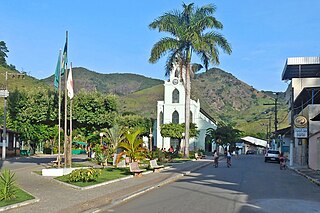
The Doce River is a river in southeast Brazil with a length of 853 kilometres (530 mi). The river basin is economically important. In 2015, the collapse of a dam released highly contaminated water from mining into the river, causing an ecological disaster.

Coronel Fabriciano is a municipality in the state of Minas Gerais in the Southeast region of Brazil. It is located in the region of Vale do Rio Doce and is situated 200 km from the state capital. The municipal population was estimated in 2020 by IBGE in 110,290 inhabitants. The area is 221.252 km2 (85.426 sq mi).

Caparaó National Park is a national park created in 1961 to protect the Caparaó Mountains, located on the border between Minas Gerais and Espírito Santo states in Brazil. Pico da Bandeira, one of the highest mountains in Brazil, is located there.

Timóteo is a Brazilian municipality in the state of Minas Gerais, located by the Piracicaba River. The population as of 2020 was 90,568 inhabitants. The city is situated in the metropolitan area of the Steel Valley. It is the hometown of Aperam South America, a steel factory specialized in the production of stainless steel, now named Aperam.

Dionísio is a municipality in the state of Minas Gerais, Brazil. The city belongs to the mesoregion Metropolitana de Belo Horizonte and to the microregion of Itabira. As of 2020, the estimated population was 7,609.

The Piracicaba River is a watercourse of Minas Gerais state in southeastern Brazil. It is a tributary of the Doce River. The river rises at an altitude of 1,680 metres (5,510 ft), at one of the vertices of the Caraça mountain range, in the São Bartolomeu district. It runs for 241 km to its mouth on the Doce river, between Ipatinga and Timóteo. Its main tributaries are the Prata, Peixe, Maquiné and Santa Bárbara rivers and the Turvo stream. The basin covers 5,465.38 km2 of drainage area and a total of 21 municipalities.

Marliéria is a municipality in the state of Minas Gerais in the Southeast region of Brazil.

Events in the year 1967 in Brazil.

The Gruta da Lagoa Azul State Park is a state park in the state of Mato Grosso, Brazil. Its primary attraction is a limestone cave with a pool of blue water and unusual cave formations. These have suffered from vandalism, causing the cave to be closed until measures to protect it could be implemented.

The Serra do Papagaio State Park is a state park in the state of Minas Gerais, Brazil. It protects a mountainous region of Atlantic Forest.
The Paraíso Ecological Station was an ecological station in the state of Rio de Janeiro, Brazil. In 2013, it was absorbed into the Três Picos State Park.

The Biribiri State Park is a state park in the state of Minas Gerais, Brazil. It protects a mountainous region of cerrado. The park contains an abandoned village, once home to workers in a textile factory, which is now a tourist attraction.
The Serra dos Parecis State Park was a state park in the state of Rondônia, Brazil. It was meant to protect an area of Amazon rainforest, but after being abandoned for twenty years it was cancelled in 2010.

The Pico do Itambé State Park is a state park in the state of Minas Gerais, Brazil. It protects one of the higher peaks in the state.

The Caminho dos Gerais State Park Portuguese: Parque Estadual Caminho dos Gerais is a state park in the state of Minas Gerais, Brazil. It protects a mountainous area with cerrado and caatinga vegetation that is an important source of water in a dry region.

The Serra Negra State Park Portuguese: Parque Estadual da Serra Negra is a state park in the state of Minas Gerais, Brazil. It protects a mountainous area in the Atlantic Forest biome, an important source of water in a dry region, and a potential source of tourism revenue in an area with many social problems.

The Rio Preto State Park is a state park in the state of Minas Gerais, Brazil. It protects a mountainous area of cerrado vegetation that is home to various endemic, rare or endangered species. Trails provide environmental interpretation, and lead to lookouts that give panoramic views, to rivers and waterfalls, and to archaeological sites with rock paintings.

The Serra Nova State Park Portuguese: Parque Estadual de Serra Nova is a state park in the state of Minas Gerais, Brazil. It protects an area of rugged terrain with considerable diversity of flora and fauna.

The Rio Doce State Park is a state park in the state of Minas Gerais, Brazil. It protects a large remnant of Atlantic Forest, and includes a system of lagoons rich in species of native fish.
The 1979 Brazilfloods were a series of events that primarily affected the states of Minas Gerais, Bahia, and Espírito Santo.

















